Stable share of Americans have been participating in some way – either virtually or in person – during the pandemic, but in-person attendance is slightly lower than it was before COVID-19
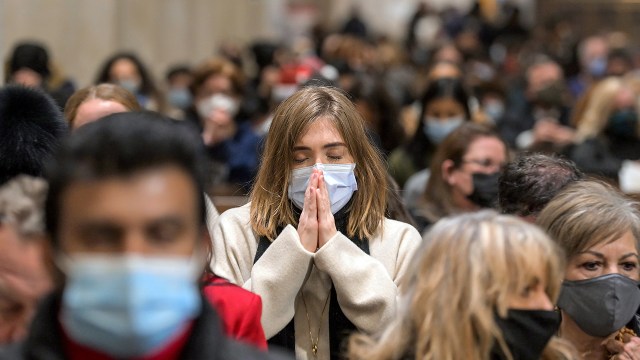
Pew Research Center conducted this analysis to continue tracking trends in Americans’ attendance at religious services – both virtually and in person – during the COVID-19 era. The newest survey included 11,377 U.S. adults and was conducted Nov. 16-27, 2022. We also include data from several other surveys over the last few years, in some cases limiting the analysis only to those respondents who took all the surveys.
The surveys measure religious attendance in a few ways. One question asks how often respondents attend religious services in general (more than once a week, once a week, once or twice a month, a few times a year, seldom, or never). Another question asks whether respondents have attended religious services in person within the past month, while a similar question asks whether respondents have watched religious services online or on TV within the past month.
Because the Center started asking about virtual participation in religious services only after the coronavirus outbreak, we cannot definitively say whether overall attendance (both in person and online/on TV, combined) is higher or lower than it was before the pandemic. However, this report analyzes the available data in multiple ways to try, as best we can, to address the big-picture question: How has the pandemic affected attendance at religious services?
All respondents to the surveys are part of Pew Research Center’s American Trends Panel (ATP), an online survey panel that is recruited through national random sampling of residential addresses. This way nearly all U.S. adults have a chance of selection. The survey is weighted to be representative of the U.S. adult population by gender, race, ethnicity, partisan affiliation, education, religious affiliation and other categories. For more, see the ATP’s methodology and the methodology for this report.
The questions used in this analysis can be found here.
Key takeaways from this report
To assess the impact of the pandemic on worship attendance rates, this report looks at Pew Research Center’s survey data in four different ways:
- Five surveys conducted since the start of the pandemic (beginning with a survey in July 2020) show that a remarkably steady share of Americans – about 40% – say they have participated in religious services in the prior month one way or the other (either in person or virtually, i.e., by streaming online or watching on TV).
- Asked directly whether they now attend religious services more or less often than they did before the pandemic, more Americans indicate that their attendance habits have declined than risen. But it’s a complicated picture: As of November 2022, 20% say they are attending in person less often (while 7% say they are going in person more often). On the other hand, 15% say they are participating in services virtually more often (while 5% say they are watching services online or on TV less often).
- The share of U.S. adults who say they generally attend religious services once a month or more has dropped slightly, from 33% in 2019 to 30% in 2022.
- A longitudinal analysis of the survey data – tracking the same individuals’ answers on four annual surveys from 2019 to 2022 – finds that the vast majority (87%) report no change in their rates of worship attendance over that period. But among those who do indicate a change, more report attending services less often (8%) than report attending more often (4%).
Since the World Health Organization declared COVID-19 a global pandemic three years ago, observers of religious life in America have wondered whether – and how – the upheaval would impact religious worship. Would the temporary shuttering of churches and other houses of worship accelerate the longer-term decline in attendance, especially if many people who stopped attending religious services in person during the pandemic never go back? Or could the widespread introduction of virtual services extend congregations’ geographic reach, increase their appeal to young people and help them attract new audiences?
There are some indications that in-person engagement in religious services has declined slightly since 2019, before the COVID-19 outbreak. The share of all U.S. adults who say they typically attend religious services at least once a month is down modestly but measurably (by 3 percentage points, from 33% to 30%) over that span, and one-in-five Americans say they now attend in person less often than they did before the pandemic.
At the same time, the share of U.S. adults who take part in religious services in some way (in person, virtually or both) in a given month has remained remarkably steady since the early days of the pandemic – even though how they participate has shifted dramatically.
Pew Research Center has conducted five surveys since the summer of 2020 in which we asked U.S. adults whether they attended religious services in person in the prior month and, separately, whether they took part virtually (by streaming online or watching on TV).
In the first of those polls, in July 2020 – when many churches, synagogues, mosques and other houses of worship were limiting attendance or closed to physical worshippers – 41% of adults said they had joined in religious services in one of these ways (either in person or virtually) in the past month. Most of them (27% of all U.S. adults) said they had participated only virtually. An additional 9% said they had attended in person and watched virtually. Just 4% said they had gone to church or other religious services only in person in the month prior to the July 2020 survey.
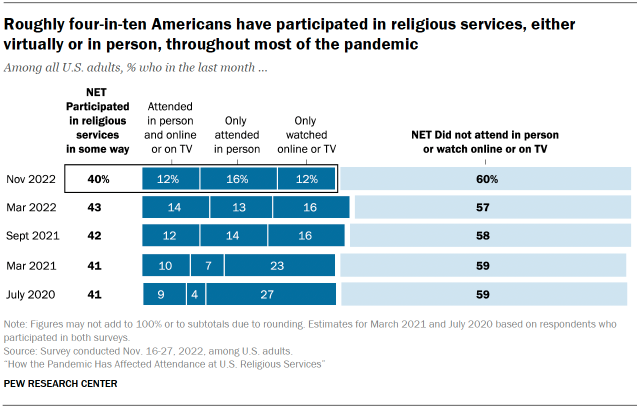
Since then, the total share of U.S. adults participating in religious services has barely budged, hovering around four-in-ten. But as the pandemic has run its course and many religious congregations have reopened their doors to worshippers, the percentage of Americans participating virtually in worship services has been dropping. Meanwhile, in-person attendance quickly rebounded and then appears to have plateaued. In the most recent survey asking these questions, in November 2022, 12% say they participated only virtually in the past month (down from 27% in the first year of the pandemic), while 16% say they attended only in person (up from 4% in 2020). An additional 12% say they did both.
Trends in attendance among religious groups
Overall, 28% of U.S. adults now say they attended religious services in person in the last month, practically unchanged from the last time we asked this question in March 2022 (27%) and only slightly higher than in September 2021 (26%). Those surveys indicated a significant rise of in-person attendance from March 2021 (17%) and July 2020 (13%). By contrast, the share of Americans who say they watched religious services online or on TV in the last month dropped in the new survey, from 30% in March 2022 to 24% in November.
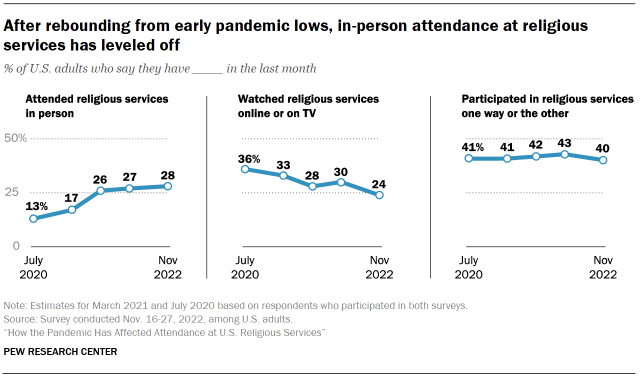
Throughout the pandemic, White evangelical Protestants consistently have been the most likely of the country’s major religious groups to attend services in person. The portion of White evangelicals who report that they physically went to church in the past month has not dropped below 30% at any point since July 2020. In the most recent survey, fully half of White evangelicals (52%) say they attended in person.
Black Protestants have experienced a substantial bounce in physical attendance, from a low of 14% in July 2020 to 41% in the recent survey. But Black Americans also have suffered a disproportionately high share of COVID-19 hospitalizations and deaths relative to White Americans, and Black Protestants remain the U.S. religious group most likely to be viewing services virtually. In the most recent survey, about half of Black Protestants (54%) say they participated in services online or on TV in the last month, compared with 46% of White evangelical Protestants and smaller shares of Catholics (20%), White non-evangelical Protestants (19%) and Jews (16%). (This report cannot analyze the attendance patterns of Muslims, Buddhists, Hindus and other smaller non-Christian religious groups due to sample size limitations.)
When it comes to party affiliation, Republicans and Republican-leaning independents have been much more likely than Democrats and Democratic-leaning independents to attend religious services in person – as well as somewhat more likely to participate virtually – throughout the pandemic.
Older Americans tend to be more religious than young adults, and despite being at greater risk of hospitalization and death from COVID-19, Americans ages 65 and older have generally been somewhat more inclined than young adults (ages 18 to 29) to go to religious services in person. Older Americans also report participating in religious services virtually at higher rates than the youngest adults.
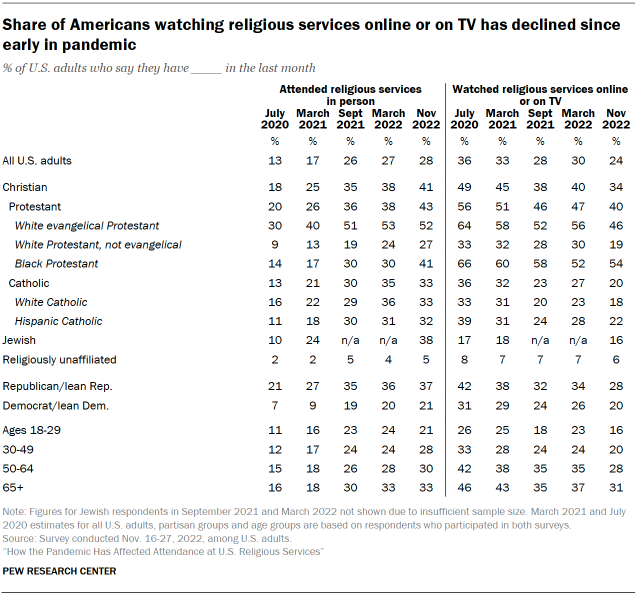
In the most recent survey, about half of adults 65 and older say they attended services in the past month, including a third who went either only in person (18%) or both in person and virtually (15%). That compares with roughly three-in-ten adults under 30 who say they participated in religious services in any way, including about one-fifth who went either only in person (12%) or both in person and virtually (9%).
Throughout most of the pandemic, about six-in-ten Americans have not taken part in religious services in any way. In the new survey, this includes roughly seven-in-ten adults under 30 (72%) and about nine-in-ten religiously unaffiliated adults (those who describe their religious identity as atheist, agnostic or “nothing in particular”).
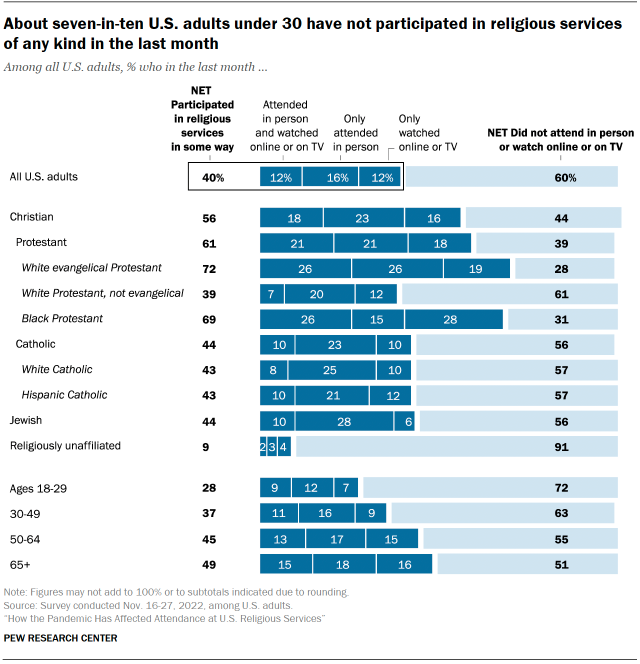
These are among the key findings of a new analysis of Americans’ religious attendance, based on a Pew Research Center survey conducted Nov. 16-27, 2022, on the nationally representative American Trends Panel, as well as several older surveys.
Survey questions have changed since the pandemic began
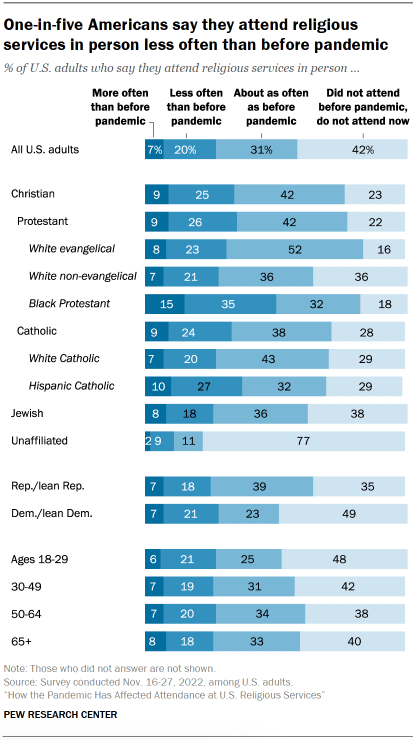
Prior to the pandemic, the Center did not routinely ask people whether they watched religious services online or on TV. And although our surveys have long asked respondents how often they generally attend religious services, we did not regularly ask whether they actually went to services in the prior month. Consequently, there is no clear, pre-pandemic baseline with which to compare these current indicators of participation in religious services.
However, the new survey posed a question to respondents asking whether they currently attend religious services in person more often, less often or about as often as they did before the pandemic. A second question asked the same thing about how often they watch services virtually now, compared with before the pandemic.
One-in-five U.S. adults say they now attend religious services in person less often than they did before the pandemic. This share is partially offset by 7% of Americans who report attending in person more often than before COVID-19.
Furthermore, among those who say they attend religious services in person less often than they did before the pandemic, about a third (7% of all U.S. adults) say they now watch religious services online or on TV more often than before the pandemic.
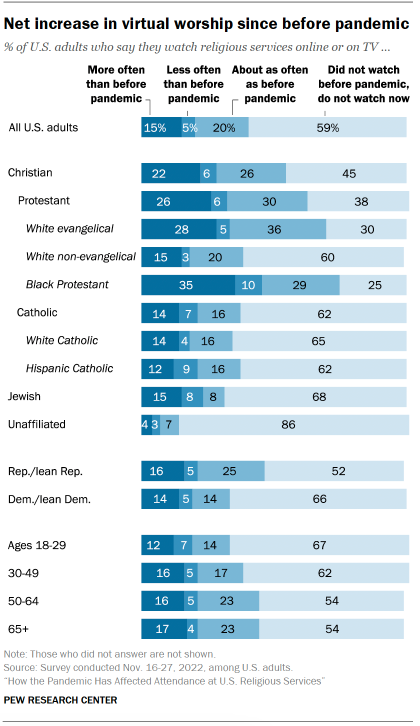
Most Americans either say they attend in person at about the same rate as before the COVID-19 outbreak (31%) or that they did not attend religious services before the pandemic and still do not (42%).
Overall, 15% of U.S. adults say they now watch religious services online or on TV more often than they did before the pandemic, compared with just 5% who report doing this less often. About eight-in-ten say their participation in virtual worship is little changed, including 59% who say they did not do this at any time.
Black Protestants stand out as being particularly likely to say they attend in-person services less often than they did before the pandemic (35%), although an identical share say they now watch religious services online or on TV more often than they used to – a number that is also higher than in other U.S. religious groups.
Tracking the same respondents over time: How individuals’ religious attendance habits have changed
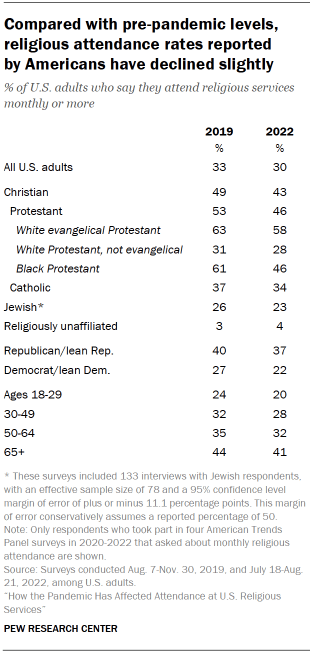
While it was only after the outbreak of the pandemic that Pew Research Center started asking respondents whether they attended religious services in person in the past month or watched them virtually during that same period, we have used a different question to measure religious attendance for decades. This older question asks, “Aside from weddings and funerals, how often do you attend religious services? More than once a week, once a week, once or twice a month, a few times a year, seldom, or never?”
One advantage of the American Trends Panel is that it surveys many of the same respondents repeatedly over time, allowing researchers to compare how nearly 6,000 people described their general religious attendance habits before the pandemic with how the same individuals answered that question at various points more recently.
This longitudinal analysis finds a slight decrease in the share of respondents who say they generally attend religious services at least once a month, from 33% in 2019 (prior to the pandemic) to 30% in 2022. It is not clear whether the dip is continuing a longer-term trend or mostly reflects the short-term impact of the pandemic on religious Americans, particularly Black Protestants.
The share of Black Protestants who say they generally attend religious services at least once a month is now 15 points lower than in 2019 (46% vs. 61% then). No other religious group has registered a decline of this magnitude.
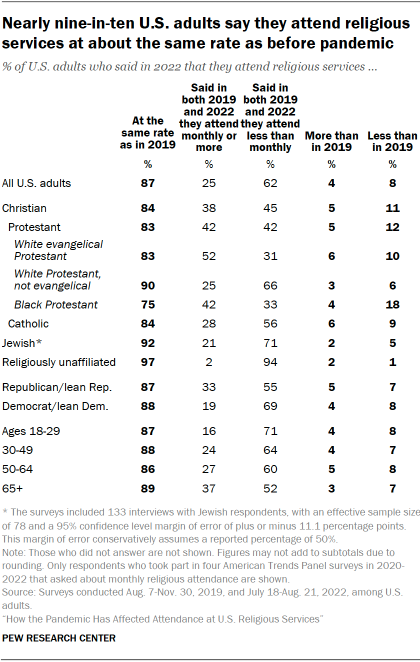
The vast majority of respondents who took all four annual surveys (87%) described their attendance habits in roughly the same way in 2019 and 2022.1 Specifically, a quarter of Americans said they attended services at least monthly in both 2019 and 2022, while 62% said they attended less than monthly both before the pandemic began and more recently.
While most Americans did not report significant changes in their religious service attendance over the course of the pandemic, the share who now indicate they are attending less often than they did before the initial COVID-19 outbreak shuttered many in-person services is slightly larger than the share who say they are going more often: 8% of respondents to both surveys said in 2019 that they typically attended at least monthly but say in 2022 that they now typically attend less than monthly, including 4% who say they seldom attend or no longer attend at all. An additional 4% of Americans said in 2019 that they typically attended religious services less than monthly but say that as of 2022 they attend at least monthly, including 2% who seldom or never attended prior to the pandemic (and who now indicate they attend at least monthly).
A similar pattern can be found among a variety of demographic subgroups, including several religious traditions, political parties and age ranges. In most groups, a slightly larger number of respondents reported attending less often in 2022 (compared with 2019) rather than more often, though the vast majority of respondents showed no change in their self-reported general level of religious service attendance over this period.
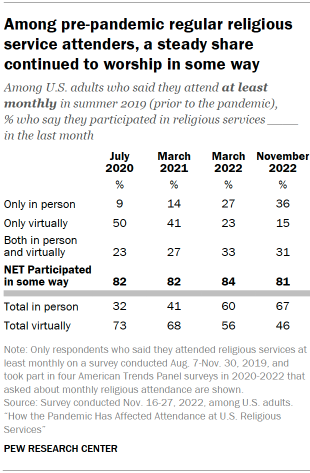
The way Americans have engaged with religious services has changed dramatically over the last few years. But among respondents who said before the pandemic that they typically attended religious services at least monthly – and who took each of four annual surveys that asked about monthly attendance between July 2020 and November 2022 – the share who say they actually participated either in person or virtually in the month prior to each survey has remained stable over the course of the pandemic, at around or just above eight-in-ten.
In July 2020, only about one-third of pre-pandemic typical attenders (32%) said they actually had attended in person in the last month. But nearly three-quarters (73%) said they attended religious services virtually, including some who attended in person as well, making for a total of 82% who attended in at least one of these two ways.
The November 2022 survey shows how much things have changed: About two-thirds of U.S. adults who said they typically went to church or other religious services at least monthly prior to the pandemic (67%) say in the new survey that they actually attended in person in the last month, while 46% watched virtually (including 31% who did both). But, in total, the share who took part in religious services either in person or virtually (81%) is nearly identical to what it was in July 2020.
While half of pre-pandemic regular attenders said in July 2020 that they only watched religious services virtually, this percentage dropped to 15% in November 2022. Meanwhile, the share who attended only in person has risen from 9% in July 2020 to 36% in November 2022.
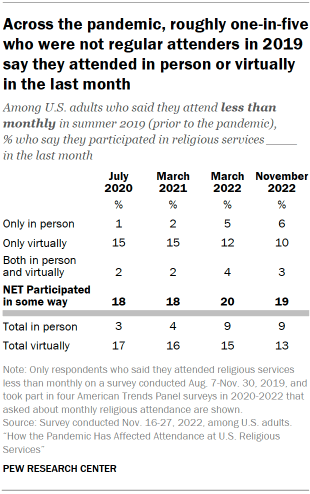
Just as some people who describe themselves as regular attenders at religious services may not actually watch religious services virtually or attend in person in a given month, some people who say they do not typically attend religious services report that, actually, they did attend in the past month. This share also appears stable over the course of the pandemic: In each survey, among people who said before the pandemic that they typically attended religious services less than monthly, about one-in-five say they actually participated in services in the last month either in person or virtually.
At the beginning of the pandemic, monthly participation was overwhelmingly virtual among this group (17% attended virtual services, compared with 3% in person). However, in the most recent survey, the shares who say they engage in each type of attendance are more evenly balanced (13% virtual, 9% in person). There was little change between attendance levels in March and November of 2022, which may indicate that in-person and virtual participation has leveled off within this group of people.


